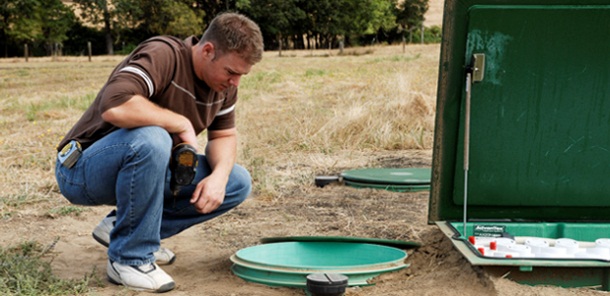The business of finding solutions to difficult onsite wastewater challenges is right up R.C. Worst & Co.’s alley. For the past 9 years,
R.C. Worst & Co. has been solving difficult, onsite wastewater issues with Orenco’s AdvanTex Wastewater Treatment Systems. The AdvanTex falls into the Idaho Department of Environmental Quality’s (IDEQ) description of an Extended Treatment Package System or ETPS. Although there are a few ETPS manufacturers IDEQ has identified as being acceptable to use in Idaho, the AdvanTex system has consistently met IDEQ requirements as evidenced by data collected through annual inspection and reporting of installed systems.

ecently, there has been much debate among the regulatory community, as well as some ETPS providers, on what constitutes a well-functioning ETPS. On November 15, 2012, a scheduled meeting of an IDEQ subcommittee known as the
Extended Treatment Package Subcommittee was held at the IDEQ office in Boise. The subcommittee is under the direction of the Technical Guidance Committee (TGC) of IDEQ. Barry Burnell, IDEQ’s Water Quality Division Administrator, presented to members of the committee, as well as several guests, the history of the ETPS program and chronologically described the progression of the program beginning in the Mid-1970’s when health districts issued permits for Alternative Treatment Units (ATU) when standard systems could not meet setbacks to ground water. At the time, there were no Operation and Maintenance (O&M) requirements. In the late 1970’s- ATU systems began failing and health districts ceased issuing permits for the ATUs.

Barry Burnell, IDEQ
Burnell went on to describe the introduction of the Technical Guidance Manual (TGM) in 1985 as authored by Tom Turco, the Environmental Health Director at Central District Health Department,
Panhandle Health District Supervisor Ken Babin and Gary Shook of IDEQ. This occurred in conjunction with a major Subsurface Sewage Disposal Rule rewrite. A majority of the manual was based on information received from an American Society of Civil Engineers (ASCE) conference on subsurface wastewater systems. Within the TGM was a section specific to ETPS to include the concept of receiving for review and then recognizing non-profit O&Ms as the responsible entities to insure proper function of the installed ETPS. 25 non-profit O&M entity requirements were included in the development of this section and were based primarily off of a local engineering firm study of homeowner entities. In 2000, the TGM changed O&M Item 17 to specifically include monitoring and testing as outlined in the ETPS section.
Burnell spoke to the progression of system testing criteria for the ETPS program that initially included testing for Biological Oxygen Demand (BOD) and Total Suspended Solids (TSS). This required an effluent reduction of 85% from 200 mg/L to 30 mg/L for both BOD and TSS. In 2001 IDEQ added Total Nitrogen to testing requirements in conjunction with Nutrient Pathogen study requirements and in 2008 he noted a shift from BOD to Carbonaceous Biological Oxygen Demand (CBOD5) to reflect the
National Science Foundation (NSF) testing criteria and changed the reporting requirements from calendar year to July-June. Adjusted systems were required to be tested and a grace period was allowed for system start-up and medical issues. In 2009, some of the O&M entities presented concerns to the TGC related to the 30/30 BOD and TSS requirements and that the testing did not follow NSF criteria. After discussion, the TGC changed the requirements in the TGM to 40 mg/L CBOD5 and 45 mg/L TSS. This change reflects the weekly testing criteria NSF uses rather than the monthly averages of 30/30.
Burnell closed his presentation by stating the importance of the service and testing components of the ETPS program. He stated that as important as changes to the service and testing elements have been through the maturing process of the program, additional scrutiny and future changes will be needed to insure longevity.
During other meeting discussion, the committee spoke specifically about topics such as end user conformity to annual testing, the issues surrounding transition of ownership of registered O&M entities, the inclusion of manufacturers as part of setting up O&Ms and closer scrutiny of how the O&Ms are developed including Board of Director makeup. Additionally, IDEQ’s On-Site Wastewater Coordinator Tyler Fortunati provided an overview of the current status of O&M entities in the State of Idaho. He included a table as visual reference that indicated O&M entities that are suspended, the number of units installed per entity and by health district, and the overall number of systems installed that are under suspended entities and operating entities within the State of Idaho.
The question begged by many providers, installers and concerned regulators is, how do we as responsible industry professionals insure that all IDEQ approved and installed ETPS are properly maintained and that critical testing data is being reported? The establishment of the TGC subcommittee is a good start and serious discussion has already taken place by many interested parties on how to address what appears to be a significant number of installed ETPS that are not being reported on or that have been, through various circumstances, determined to be malfunctioning. This subcommittee of the TGC may be the forum where regulators that are tasked to insure public safety and responsible onsite wastewater professionals come together to address this important issue.